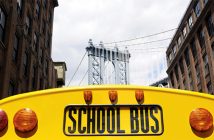
At Two Rivers Public Charter School in the District of Columbia, for a fourth-grade unit on Jamestown, students studied historical documents and made a timeline of events that took place in the first permanent English settlement in the US. They also did research on the different groups of people who lived there and wrote fictional stories from a variety of perspectives.
They even visited the Virginia settlement. Students were excited about going on the ships anchored there, holding swords, and even putting on armor. The school calls a trip like this an expedition, which is an instructional unit that is made up of interactive, project-based learning, says Michael Alison Chandler of The Washington Post.
The process is receiving good reviews, particularly at a time when parents and educators are troubled by the focus on accountability based on testing that has caused rote learning, taken the fun out of learning, and is failing to prepare young people for the rigors of today’s workplace.
The enrollment lottery takes place in the District on December 14, so families are visiting schools and attempting to make sense of the different styles, models, and curricula. They can see teaching in the Tools of Learning, No Excuses, Dual Language, Montessori, and Reggio Emilia styles.
But Expeditionary learning has attracted a large amount of attention. The Two Rivers school had the longest waitlist of any charter last spring. The next two schools with the highest numbers on their wait lists belonged to Mundo Verde and Capital City, both of which have adopted the expeditionary model. Their emphasis on skills such as character development, perseverance, and risk-taking, among others, has made the three schools highly desirable.
The schools are affiliated with an organization called EL Education, which was created over two decades ago because of a partnership between Outward Bound and the Harvard Graduate School of Education. Based in New York, the group is based on 10 “design principles” which include such doctrines as “The Primacy of Self-Discovery.”
Through being involved in “situations that offer adventure and the unexpected,” students work to find their abilities, values, passions, and responsibilities. There is also “The Having of Wonderful Ideas,” that means “students need opportunities to explore their curiosities, time to experiment, and time to make sense of what they learned.”
EL Education has experienced what President and Chief Executive Scott Hartl calls “explosive growth” as states are rehauling academic standards and the tests that follow to build more critical thinking and problem solving. EL Education also trains teachers and shares resources with school districts and was asked by the state of New York to write a literacy curriculum.
In California, Sierra Expeditionary Learning School (SELs) was singled out at the EL Education National Conference in San Diego in October for reaching “credentialed” status within its network of schools. Of 152 EL Education schools nationwide, SELS is among 23 to have this honor.
Schools must demonstrate excellent performance in Student Mastery of Knowledge and Skills, Student Character, and High-Quality Student Work to achieve this distinction.
At the national conference, staff members and students led Master Classes on the SELS TEDx program and student leadership, reports the Sierra Sun.
The EL Education website details the five key dimensions of life in school: real-world curriculum, invigorating instruction, assessment of student learning, respectful culture and character, and leadership. These offer an outline that makes the EL Education network of schools high-achieving and engaging.
The 10 Building Blocks of the EL Education model are The Primacy of Self-Discovery, The Having of Wonderful Ideas, The Responsibility for Learning, Empathy and Caring, Success and Failure, Collaboration and Competition, Diversity and Inclusion, The Natural World, Solitude and Reflection, and Service and Compassion.
Number of Schools Using Expeditionary Learning Model Growing
0
Share.




